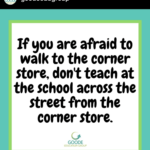“Students need to hear the joy in your voice and see the smile on your face, even if you have to fake it.”
After centuries of traditional classroom instruction, teachers and students across the country are adjusting to virtual teaching and learning. Whether you love it or hate it, it’s here to stay. Now, instructors must evolve to prevent extinction in the new world of education. To thrive as a powerful virtual teacher this school year, consider the following rules:
Rule #1: Record, then Review
As an undergraduate at The University of Texas at Arlington, my professors foreshadowed that someday I would need recorded lessons, perhaps for a job interview or my digital portfolio. Never did I imagine I would become a virtual teacher overnight and in the midst of a pandemic! Thankfully, recording virtual lessons are achievable with the right technology. Consider purchasing a laptop with an integrated camera to expedite the process. If not, you can always connect a webcam to your computer. When choosing a software to record your virtual lessons, explore free websites like Screencast-O-Matic or QuickTime Player – both have editing tools included. While recording, follow a gradual release model, commonly known as “I do, we do, you do”, so students are engaged and assessed during the lesson. Finally, post your virtual lessons onto a learning management system, such as Google Classroom, Blackboard, or even YouTube. From there, students can review at their own time and pace. Ultimately, this will alleviate stress for absent students, and provide you with proof of virtual instruction for your portfolio.
Rule#2: Communicate Often
When virtual learning first started, teachers across the world had to find innovative ways to communicate with their students. No longer could we pick up our school phones and dial the number nine twice. Instead, we had to download free apps like Remind, Google Voice, and even GroupMe. In the words of Kevin Gates, “I got two phones” – one for my personal life, and the other for my beloved students and parents. Actually, I have one phone with two cell numbers, thanks to Google Voice! Now, when students and parents call me, I receive a verbal notification of the caller, and access to written text and voicemail messages. Such simple documentation! You may wonder, “What about my school email address?” Outlook and Gmail are ideal for mass communication to parents and students; however, consider sending a Remind message or Google Voice text for instant feedback.
Rule #3: Assess with Games
While teaching and learning is now virtual, teachers are still responsible for assessing their students on specific standards. Today, there is a plethora of free websites and applications designed to help teachers assess and evaluate student knowledge and growth. For example, I am devoted to the website Quizizz, where I can create, find, and even modify an existing quiz. While students suspect they are playing an academic game, I am collecting data! Whether I conduct Quizizz live, or assign it as homework, I ensure that my students are constantly assessed. This upcoming school year, explore game-based learning platforms like Quizizz or Kahoot to add engagement as you assess. If you are evaluating written assignments, consider applications like Google Forms, which I also use faithfully.
Rule #4: Allow Brain Breaks
Since the start of virtual instruction, I have suffered from both internal and external interruptions. As a result, I designated a teaching spot within my home, which displays the sign, “Do not disturb”. Every thirty minutes to an hour, I leave my teaching spot to walk in place, around my home, or even my neighborhood. Similar to my desire to disconnect, students need the same. To keep students engaged and energized, include brain breaks into your lesson. Whether five minutes or fifteen, allow students the opportunity to step away, stretch, then refocus onto your content.
Rule #5: Plan During PLC
If you’ve never heard of the educational term PLC, it is defined as a professional learning community. Generally, PLC is designated time to meet and plan with teachers of a specific content or grade level. By means of Zoom, Skype, and Google Hangouts, PLC is alive and well for educators planning in a virtual setting, but it is only effective with participation from all stakeholders. If you are a content leader, consider communicating your expectations about PLC, and collaborating with your teachers on specific norms and goals to promote successful virtual meetings. If you are a teacher, put forth your best effort to actively engage in PLC by contributing your skills and talents. Together, both content leaders and teachers can plan for student achievement on one accord.
Rule #6: Keep it Culturally Responsive
Who said you can’t implement media, pop culture, or sports into your virtual lesson? Your virtual classroom is still a platform for student engagement. When planning your lesson, ask yourself, “How can I hook my students?” Considering the distractions students face in virtual settings, it is wise to meet them on their level by implementing YouTube clips, trending Tweets, and controversial news that will stimulate social-emotional discussions related to your academic content. If possible, find time to discover your students’ interests, hobbies, and favorite entertainers. Doing so will allow you to plan captivating lessons that are intentional, and customized to their culture.
Rule #7: Invite Students to Your Virtual Club
Around April, I won an educational competition that awarded several copies of The Poet X by Elizabeth Acevedo. Originally, I planned to use the books for my student book club, which was set to occur weekly after school. Due to the pandemic, I facilitated a virtual book club via Zoom to discuss the novel, and students had a blast sharing their insight on the novel! If I can successfully facilitate a virtual club, you can too! Ask yourself, “What is my hobby? Hobbies can range from writing poetry, to playing Esports, to watching Anime. Next, ask yourself, “Would students enjoy this same hobby in a virtual setting?” If so, create a virtual club, and invite your students! Undoubtedly, students will not only look forward to attending, but will help you recruit more students.
Rule #8: Show Your Face, and Smile
At this point, stress is inevitable. Unfortunately, students are suffering the most as they ponder the physical possibilities of athletics, prom, and graduation. For some, teachers will make all the difference this school year. Their attentiveness, optimism, and smile will foreshadow hope and healing for students. So, despite your subject and teaching schedule, put forth the effort to turn on your camera when teaching students in a synchronous setting – they need to see you. Students need to hear the joy in your voice and see the smile on your face, even if you must fake it. If your students choose not to turn their camera on, you should continue to set an example as the teacher, their leader. Take it a step further by ensuring your background is clean, clear, and somewhat colorful. Trust me, no student will grasp a complicated concept amid a cluttered background or noisy cat.
Rule #9: Showcase Student Work
Last spring, my students were responsible for submitting a final project that was cumulative, yet creative. Expressly, they created short stories that included complex English concepts, and submitted them on multimedia platforms. While grading the final projects, I was fascinated by the amount of effort put forth by most students! Instantly, I felt compelled to share their work beyond the walls of our virtual classroom. After considering various options, I decided to create an end of year newsletter. Although the newsletter was only five pages, it was compact with pictures taken before the Covid-19 pandemic, links to students’ final projects, encouraging poems, and a thank you note. Upon emailing the newsletter to all my students and parents, I received countless responses of gratitude. If you are wondering how to showcase your students’ work, consider composing a monthly newsletter to display their academic efforts, or even creating a classroom Instagram page for your students and parents to follow. Recognizing your students often will keep the virtual morale high.
Rule #10: Conduct Virtual Visits
Every great teacher is familiar with his or her students. We know when all is well, but can also sense trouble in paradise. In a virtual classroom, building and maintaining student relationships are challenging, but necessary. Once, I called a parent to communicate my concerns about her student, who stopped submitting his work on time. To my surprise, the mother not only answered, but was ecstatic to speak with me about her son! She confirmed he was physically well, but discouraged by the lack of attention he was receiving from teachers he once visited after school on a daily basis. Upon following up with the student on a Zoom call, he expressed his feelings towards topics outside of academics, like playing high school football in the midst of a pandemic. The conversation was both refreshing and rewarding! If you have any spare time between teaching, planning, or grading, spend it by conducting virtual visits with your students – they’ll thank you later.
Cora Garner
@MsCoraGarner
Cora Garner is an educational leader, servant, and visionary. She is an English teacher at DeSoto High School, and doctoral student at the University of Texas at Arlington.




